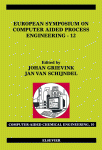 Authors: M.MANGOLD¹, K.D.MOHL², S.GRÜNER², A.KIENLE¹, E.D.GILLES²
Authors: M.MANGOLD¹, K.D.MOHL², S.GRÜNER², A.KIENLE¹, E.D.GILLES²
Affiliations: ¹Max-Planck-Institut für Dynamik komplexer technischer Systeme, Sandtorstraße 1, D-39106 Magdeburg, Germany; ²Universität Stuttgart, Institut für Systemdynamik und Regelungstechnik, Pfaffenwaldring 9, 70569 Stuttgart, Germany
Reference (APA): Mangold M., Mohl K.D., Gruner S., Kienle A., Gilles E.D. (2002). Nonlinear analysis of gPROMS models using DIVA via a CAPE ESO interface. Computer Aided Chemical Engineering, 10 (C), pp. 919-924. https://doi.org/10.1016/S1570-7946(02)80181-X
Abstract: “The CAPE ESO interface of the process simulator gPROMS is used to pass model information to numerical methods contained in the simulation environment DIVA. By the interface, algorithms for the continuation of stable and unstable steady state and periodic solutions can be applied directly to gPROMS models. The use of the interface is illustrated by a detailed nonlinear model of an industrial reactive distillation column. ”
Comments: DIVA offers a package of continuation methods that prove efficient to apply bifurcation analysis. gPROMS is able to create a CAPE-OPEN Equation Set Object (ESO) that is passed to DIVA which serves as an external solver. DIVA sets the variables of the gPROMS model and receives information on the residuals and Jacobians through the ESO interface. On an industrial reactive distillation column provided by Bayer AG, the authors compare computation times between, on one side, the case where model and resolution are made in DIVA, and, on the other side, the case where the model is in gPROMS and DIVA acts as solver of the system of 250 differential equations and 5207 algebraic equations. If the computation time doubles from the integrated to the distributed arrangement, the authors consider the overhead tolerable “and is certainly preferable to the time consuming and error prone re-implementation of a complex model in a new software environment“. For the authors the CAPE-OPEN interface is “an efficient way to transfer new numerical methods from academia to applications in industry“.
